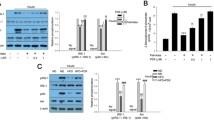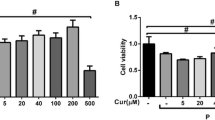Abstract
Studies have shown that sulforaphane (SFN) has potent anti-inflammatory and free radical scavenging effects on obesity and associated disorder such as diabetes, polycystic ovary syndrome, and metabolic syndrome. fractalkine (CX3CL1) and its receptor, CX3CR1, play an important role in muscle metabolism by improving insulin-sensitizing effects. Here, in this study we examined the SFN effect on CX3CL1 and its receptor, CX3CR1, in C2C12 myotubes in palmitic acid (PA)-induced oxidative stress and inflammation. The results showed that PA (750 μM) evoked lipotoxicity as a reduction in cell viability, increased IL-6 and TNF-α expression, and enhanced reactive oxygen species (ROS). However, SFN pretreatment attenuated the levels of, IL-6 and TNF-α in C2C12 myotubes exposure to PA. Moreover, SFN pretreatment up-regulated nuclear factor erythroid related factor 2 (Nrf2) /heme oxygenase-1(HO-1) pathway protein in C2C12 cells as indicated by a decrease in ROS levels. Interestingly, PA also caused an increase in CX3CL1 and CX3CR1 expression that SFN abrogated it. We also found the protective effect of SFN agonist PA-induced lipotoxicity with promotes in UCP3 gene expression in C2C12 cells. Collectively, these findings suggest that SFN hampers the PA-induced inflammation in C2C12 cells by modulation of the Nrf2/HO-1 pathway and CX3CL1/CX3CR1 axis and may propose a new therapeutic approach to protect against obesity-associated disorders in skeletal muscle cells.




Similar content being viewed by others
References
DeBoer MD (2013) Obesity, systemic inflammation, and increased risk for cardiovascular disease and diabetes among adolescents: a need for screening tools to target interventions. Nutrition 29:379–386
Mathieu P, Lemieux I, Despres JP (2010) Obesity, inflammation, and cardiovascular risk. Clin Pharmacol Ther 87:407–416
Ndisang JF, Vannacci A, Rastogi S (2014) Oxidative stress and inflammation in obesity, diabetes, hypertension, and related cardiometabolic complications. Oxid Med Cell Longev 2014:506948
Khan IM, Perrard XY, Brunner G, Lui H, Sparks LM, Smith SR, Wang X, Shi ZZ, Lewis DE, Wu H, Ballantyne CM (2015) Intermuscular and perimuscular fat expansion in obesity correlates with skeletal muscle T cell and macrophage infiltration and insulin resistance. Int J Obes (Lond) 39:1607–1618
Jaiswal N, Gavin MG, Quinn WJ III, Luongo TS, Gelfer RG, Baur JA, Titchenell PM (2019) The role of skeletal muscle Akt in the regulation of muscle mass and glucose homeostasis. Mol Metab 28:1–13
Patsouris D, Cao J-J, Vial G, Bravard A, Lefai E, Durand A, Durand C, Chauvin M-A, Laugerette F, Debard C (2014) Insulin resistance is associated with MCP1-mediated macrophage accumulation in skeletal muscle in mice and humans. PLoS ONE 9:e34976
Martins AR, Nachbar RT, Gorjao R, Vinolo MA, Festuccia WT, Lambertucci RH, Cury-Boaventura MF, Silveira LR, Curi R, Hirabara SM (2012) Mechanisms underlying skeletal muscle insulin resistance induced by fatty acids: importance of the mitochondrial function. Lipids Health Dis 11:30
Catoire M, Mensink M, Kalkhoven E, Schrauwen P, Kersten S (2014) Identification of human exercise-induced myokines using secretome analysis. Physiol Genomics 46:256–267
Polyak A, Ferenczi S, Denes A, Winkler Z, Kriszt R, Pinter-Kubler B, Kovacs KJ (2014) The fractalkine/Cx3CR1 system is implicated in the development of metabolic visceral adipose tissue inflammation in obesity. Brain Behav Immunity 38:25–35
Shah R, Hinkle CC, Ferguson JF, Mehta NN, Li M, Qu L, Lu Y, Putt ME, Ahima RS, Reilly MP (2011) Fractalkine is a novel human adipochemokine associated with type 2 diabetes. Diabetes 60:1512–1518
Lee YS, Morinaga H, Kim JJ, Lagakos W, Taylor S, Keshwani M, Perkins G, Dong H, Kayali AG, Sweet IR, Olefsky J (2013) The fractalkine/CX3CR1 system regulates beta cell function and insulin secretion. Cell 153:413–425
Stromberg A, Olsson K, Dijksterhuis JP, Rullman E, Schulte G, Gustafsson T (2016) CX3CL1–a macrophage chemoattractant induced by a single bout of exercise in human skeletal muscle. Am J Physiol Regul Integr Comp Physiol 310:R297–304
Sun CC, Li SJ, Yang CL, Xue RL, Xi YY, Wang L, Zhao QL, Li DJ (2015) Sulforaphane attenuates muscle inflammation in dystrophin-deficient mdx mice via NF-E2-related factor 2 (Nrf2)-mediated inhibition of NF-kappaB signaling pathway. J Biol Chem 290:17784–17795
Vanduchova A, Anzenbacher P, Anzenbacherova E (2019) Isothiocyanate from broccoli, sulforaphane, and its properties. J Med Food 22:121–126
Fan H, Zhang R, Tesfaye D, Tholen E, Looft C, Holker M, Schellander K, Cinar MU (2012) Sulforaphane causes a major epigenetic repression of myostatin in porcine satellite cells. Epigenetics 7:1379–1390
Bellezza I, Giambanco I, Minelli A, Donato R (2018) Nrf2-Keap1 signaling in oxidative and reductive stress. Biochim Biophys Acta Mol Cell Res 1865:721–733
Sestili P, Fimognari C (2015) Cytotoxic and antitumor activity of sulforaphane: the role of reactive oxygen species. Biomed Res Int 2015:402386
Bravard A, Lefai E, Meugnier E, Pesenti S, Disse E, Vouillarmet J, Peretti N, Rabasa-Lhoret R, Laville M, Vidal H, Rieusset J (2011) FTO is increased in muscle during type 2 diabetes, and its overexpression in myotubes alters insulin signaling, enhances lipogenesis and ROS production, and induces mitochondrial dysfunction. Diabetes 60:258–268
Glass CK, Olefsky JM (2012) Inflammation and lipid signaling in the etiology of insulin resistance. Cell Metab 15:635–645
Gong L, Guo S, Zou Z (2020) Resveratrol ameliorates metabolic disorders and insulin resistance in high-fat diet-fed mice. Life Sci 242:117212
Guerrero-Beltran CE, Calderon-Oliver M, Pedraza-Chaverri J, Chirino YI (2012) Protective effect of sulforaphane against oxidative stress: recent advances. Exp Toxicol Pathol 64:503–508
Xu L, Nagata N, Ota T (2019) Impact of glucoraphanin-mediated activation of Nrf2 on non-alcoholic fatty liver disease with a focus on mitochondrial dysfunction. Int J Mol Sci 20:5920
Seo HA, Lee IK (2013) The role of Nrf2: adipocyte differentiation, obesity, and insulin resistance. Oxid Med Cell Longev 2013:184598
Miller CJ, Gounder SS, Kannan S, Goutam K, Muthusamy VR, Firpo MA, Symons JD, Paine R 3rd, Hoidal JR, Rajasekaran NS (2012) Disruption of Nrf2/ARE signaling impairs antioxidant mechanisms and promotes cell degradation pathways in aged skeletal muscle. Biochim Biophys Acta 1822:1038–1050
Xu Y, Fu JF, Chen JH, Zhang ZW, Zou ZQ, Han LY, Hua QH, Zhao JS, Zhang XH, Shan YJ (2018) Sulforaphane ameliorates glucose intolerance in obese mice via the upregulation of the insulin signaling pathway. Food Funct 9:4695–4701
Wafi AM, Hong J, Rudebush TL, Yu L, Hackfort B, Wang H, Schultz HD, Zucker IH, Gao L (2019) Curcumin improves exercise performance of mice with coronary artery ligation-induced HFrEF: Nrf2 and antioxidant mechanisms in skeletal muscle. J Appl Physiol (1985) 126:477–486
Moon JY, Kim DJ, Kim HS (2020) Sulforaphane ameliorates serum starvation-induced muscle atrophy via activation of the Nrf2 pathway in cultured C2C12 cells. Cell Biol Int. https://doi.org/10.1002/cbin.11377
Saleh DO, Mansour DF, Hashad IM, Bakeer RM (2019) Effects of sulforaphane on D-galactose-induced liver aging in rats: role of keap-1/nrf-2 pathway. Eur J Pharmacol 855:40–49
Sun Y, Zhou S, Guo H, Zhang J, Ma T, Zheng Y, Zhang Z, Cai L (2020) Protective effects of sulforaphane on type 2 diabetes-induced cardiomyopathy via AMPK-mediated activation of lipid metabolic pathways and NRF2 function. Metabolism 102:154002
Sirois-Gagnon D, Chamberland A, Perron S, Brisson D, Gaudet D, Laprise C (2011) Association of common polymorphisms in the fractalkine receptor (CX3CR1) with obesity. Obesity (Silver Spring) 19:222–227
Morari J, Anhe GF, Nascimento LF, de Moura RF, Razolli D, Solon C, Guadagnini D, Souza G, Mattos AH, Tobar N, Ramos CD, Pascoal VD, Saad MJ, Lopes-Cendes I, Moraes JC, Velloso LA (2014) Fractalkine (CX3CL1) is involved in the early activation of hypothalamic inflammation in experimental obesity. Diabetes 63:3770–3784
Liu W, Jiang L, Bian C, Liang Y, Xing R, Yishakea M, Dong J (2016) Role of CX3CL1 in diseases. Arch Immunol Ther Exp (Warsz) 64:371–383
Schinzari F, Tesauro M, Campia U, Cardillo C (2020) Increased fractalkine and vascular dysfunction in obesity and in type 2 diabetes. Effects of oral antidiabetic treatment. Vasc Pharmacol 128:106676
Bouzakri K, Plomgaard P, Berney T, Donath MY, Pedersen BK, Halban PA (2011) Bimodal effect on pancreatic beta-cells of secretory products from normal or insulin-resistant human skeletal muscle. Diabetes 60:1111–1121
Della Gatta PA, Cameron-Smith D, Peake JM (2014) Acute resistance exercise increases the expression of chemotactic factors within skeletal muscle. Eur J Appl Physiol 114:2157–2167
Xueyao Y, Saifei Z, Dan Y, Qianqian P, Xuehong D, Jiaqiang Z, Fenping Z, Hong L (2014) Circulating fractalkine levels predict the development of the metabolic syndrome. Int J Endocrinol 2014:715148
Lesnik P, Haskell CA, Charo IF (2003) Decreased atherosclerosis in CX3CR1-/- mice reveals a role for fractalkine in atherogenesis. J Clin Invest 111:333–340
Bezaire V, Spriet LL, Campbell S, Sabet N, Gerrits M, Bonen A, Harper ME (2005) Constitutive UCP3 overexpression at physiological levels increases mouse skeletal muscle capacity for fatty acid transport and oxidation. FASEB J 19:977–979
Acknowledgements
The authors thank the Student Research Committee, Tabriz University of Medical Sciences, Tabriz, Iran, for all support provided.
Author information
Authors and Affiliations
Contributions
All authors, YF, PH, HRN, SG, EZ, SN, MN, and AJ have participated in conception and design, analysis, interpretation of the data, drafting the article, revising article critically for important intellectual content and approval for the final version and submission.
Corresponding authors
Ethics declarations
Conflict of interest
The authors declare that there are no conflicts of interest.
Additional information
Publisher's Note
Springer Nature remains neutral with regard to jurisdictional claims in published maps and institutional affiliations.
Rights and permissions
About this article
Cite this article
Faridvand, Y., Haddadi, P., Nejabati, H.R. et al. Sulforaphane modulates CX3CL1/CX3CR1 axis and inflammation in palmitic acid-induced cell injury in C2C12 skeletal muscle cells. Mol Biol Rep 47, 7971–7977 (2020). https://doi.org/10.1007/s11033-020-05875-9
Received:
Accepted:
Published:
Issue Date:
DOI: https://doi.org/10.1007/s11033-020-05875-9




